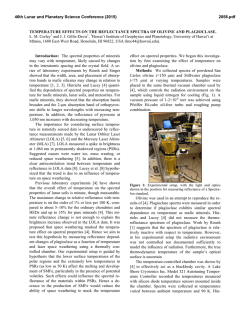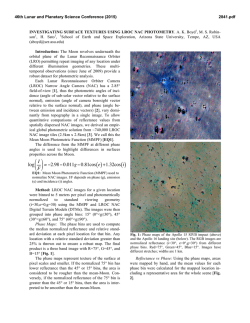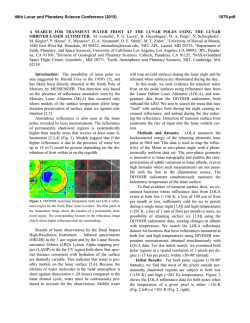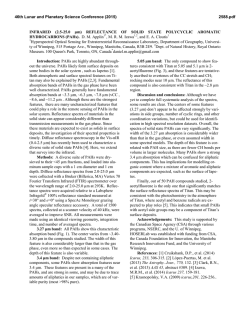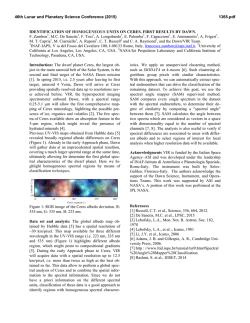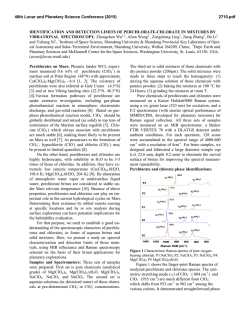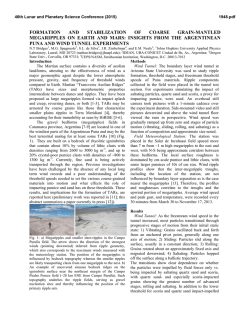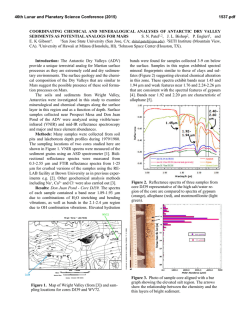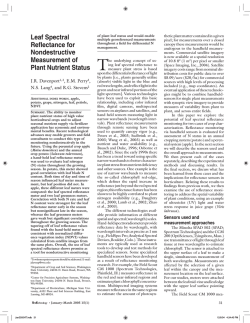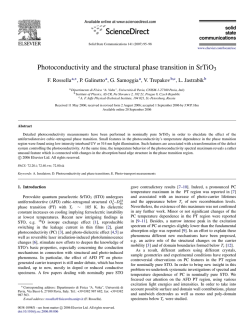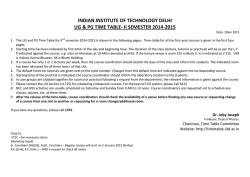
analysis of compositional variations at non
46th Lunar and Planetary Science Conference (2015) 1467.pdf ANALYSIS OF COMPOSITIONAL VARIATIONS AT NON-MARE VOLCANIC REGIONS USING LROC NAC PHOTOMETRY AND SPECTRA OF GLASSY AND SILICIC MINERAL MIXTURES. R. N. Clegg1, B. L. Jolliff1, and E. Coman1, 1Department of Earth & Planetary Sciences and the McDonnell Center for the Space Sciences, Washington University, 1 Brookings Dr., St. Louis, MO 63130 ([email protected]) Introduction: Regions of non-mare volcanism on the Moon are rare and returned samples that may be products of these regions are even rarer. These areas correlate with thorium (Th) anomalies, as detected by the Lunar Prospector Gamma-Ray Spectrometer (LPGRS), and have low FeO (<5 wt%) contents and high reflectance. These characteristics implicate an alkalisuite rock type [1]. Lunar Reconnaissance Orbiter (LRO) Narrow Angle Camera (NAC) images show morphological features that indicate volcanic origin and LRO Diviner spectral data show evidence for silicic compositions at these sites [1-4]. We use the Compton-Belkovich Volcanic Complex (CBVC), the Lassell Massif (LM), the Gruithuisen Domes, and Hansteen Alpha (HA) for this study. We have used LRO NAC photometry and Hapke photometric modeling coupled with soil composition data to place compositional constraints on these regions and assess variations in reflectance [5]. The background areas at the CBVC are highlands-type materials similar to those seen at the Apollo 16 landing site. Here we present evidence from laboratory spectra that addition of glassy silicic materials to a highlandstype simulant can account for the increased reflectance of these volcanic regions. Methods: We use NU-LHT-1M, a lunar soil simulant that was created to be an analog to highlands materials. It has a composition based on the average chemical composition of the Apollo 16 regolith and has 16% agglutinates [6]. Rhyolitic pumice from Obsidian Dome in Owens Valley, CA, is mixed with the simulant as an analog for felsic pyroclastics on the Moon. NAC Photometry: We chose regions of interest at the CBVC, LM, and HA, and one ROI at the Gruithuisen Gamma (GG) dome, and used NAC images with a variety of illumination conditions to obtain reflectance data. We then applied a Hapke photometric function that was optimized from landing site studies [7] to fit the reflectance (I/F) data (see [6]). To compare between sites and with our spectral data, we normalize I/F to a 30° phase angle, I/F(30°). Spectral Measurements: We measured the pumice using X-Ray diffraction and found that it is completely glassy with no crystalline components, making it a Table 1: Reflectance measurements of samples used for this study. Sample I/F(30°) NU-LHT pumice 50 wt% pumice 20 wt% pumice 10 wt% pumice 5 wt% pumice 0.22 0.68 0.51 0.38 0.35 0.33 Percent increase from NU-LHT 132% 71% 60% 49% good analog material for our study. The pumice was crushed and mixed in varying proportions by weight (5, 10, 20, and 50 wt%) with NU-LHT. We took spectral measurements of the mixtures using an Ocean Optics Jaz spectrometer (spectral response range of 190-800 nm) with a pulsed xenon light source. All measurements were taken at an incidence angle of 30°, emission angle of 0°, and phase angle of 30°. The LRO NACs have a spectral response from 400-750 nm, with the average falling around 650 nm. We convolve our spectral data to I/F values that are consistent with the NAC spectral responsivity. To ensure these comparisons are accurate, we took spectra of several Apollo samples (10084, 14163, 15601, and 71501) and compared their average I/F values to those recorded from our studies of landing sites [7]. Results: Extracting I/F values for regions of interest at each non-mare volcanic site and using Hapke modeling to determine I/F at a common 30° phase angle gives I/F(30°) values that range from 0.120-0.20 for the CBVC, 0.090-0.170 for HA, 0.0560.083 for LM, and average 0.070 for GG. These values are most comparable to those of the feldspathic Apollo 16 landing site, which has an I/F(30°) of 0.093 [7]. Table 1 shows the I/F(30°) values measured for the pumice, NU-LHT, and pumice+NU-LHT mixtures. The percent increase in reflectance as varying amounts of pumice were added is also reported. Figure 1a shows a plot of wt% pumice mixtures versus I/F at 30° phase angle. Figure 1b shows I/F as a function of mafics (FeO+MgO+TiO2) estimated for the pumice mixtures, using an average rhyolitic composition for the pumice. The I/F values have been convolved to match the peak spectral responsivity for the NACs. 46th Lunar and Planetary Science Conference (2015) 1467.pdf Comparatively, adding 20 wt% pumice to NU-LHT gives a 70% increase in reflectance. Therefore we infer that the addition of up to 20 wt% glassy silicic materials could account for the increased reflectance at the most reflective regions of CBVC compared to average Apollo 16 soils. The least reflective areas that we analyzed in the complex, the α- and β-domes [10] are 17% and 28% more reflective, respectively, than the Fig. 1: Relationship between reflectance (I/F) at 30° phase angle with (a) increasing background. Comparing to the amounts of pumice (by weight) mixed with NU-LHT and (b) mafic content for the samples listed in Table 1. reflectance of our pumice mixtures, the domes have less Discussion: Remote sensing data provide strong than 5% glassy silicic materials at their surfaces. As evidence for the presence of felsic materials at the these positive-relief features have degraded, any Compton-Belkovich Volcanic Complex, the Lassell mantling deposits would have been eroded by mass Massif, Hansteen Alpha, and the Gruithuisen Domes. wasting, revealing somewhat higher mafic contents Photometric studies of NAC images and spectral perhaps compositionally similar to KREEP basalts or measurements provide insight into possible other intermediate composition materials . mineralogical compositions at these areas. Conclusions: Photometric analysis of NAC images There is a linear correlation (R2=0.99) between and spectral measurements of laboratory samples increasing amounts of pumice mixed with NU-LHT provide compositional information for regions of nonand increasing reflectance values (Fig. 1a). In addition, mare volcanism on the Moon. The high reflectance at mineralogy of the varying mixtures correlates these regions is consistent with the presence of silicic systematically with reflectance. We have previously materials and low mafic contents. We have shown with shown that there is a strong anti-correlation between laboratory spectra that the increased reflectance at the the mafic (FeO+MgO+TiO2) content of Apollo and CBVC can be accounted for by the addition of ~20 Luna soils and I/F and have used this information to wt% glassy silicic/rhyolitic materials. KREEP-like extrapolate to higher I/F values for the silicic regions materials such as those seen in the Apollo 14 soil [8]. The same is true for our pumice mixtures – as samples or lower glass contents may explain the lower increasing wt% of pumice is added to the simulant, reflectance positive-relief features within the complex. total FeO+MgO+TiO2 content decreases and The lower reflectance values for Hansteen Alpha, the reflectance increases (Fig. 1b). Lassell Massif, and the Gruithuisen Domes may The CBVC, HA, LM, and GG exhibit a range of indicate intermediate felsic compositions. The reflectance values, both among the various regions and variations in reflectance among and within the CBVC, within each region. This is especially evident at the HA, LM, and Gruithuisen Domes may be attributed to CBVC, where features such as the volcanic cones and mixing of felsic components, the presence of KREEPy domes are less reflective than regions in the central materials, and/or pyroclastic deposits. Acknowledgements: We thank the LROC portion of the complex [8]. The reflectance variations Operations Team for image collection and processing, among and within each region may be due to mixing of and we thank NASA for support of the LRO mission. felsic components, addition of pyroclastic materials, References: [1] Jolliff B. L. et al. (2011) Nat. Geosci., and/or the presence of KREEPy (less silicic) materials. 4, 566-571. [2] Ashley, J. W. et al. (2013) 44th LPSC, The most reflective surfaces are the mantling deposits, Abstract #2504. [3] Glotch T. et al. (2010) Science, 329, which have been hypothesized as possible pyroclastic 1510. [4] Greenhagen B. et al. (2010) Science, 329, 1507. [5] deposits [1,9]. A small percentage of glassy materials Clegg R. N. et al. (2014) 45th LPSC, Abstract #1256. [6] Stoeser D., et al. (2010) NASA/TM-2010-216438. [7] Clegg such as silicic pyroclastics in this area would account R. N. et al. (2014) Icarus, 227, 176-194. [8] Clegg R. N. et for the increased reflectance in these regions, as al. (2014) LEAG 2014, Abstract #3032. [9] Wilson J. et al. supported by our measurements. (2015) This Conf. [10] Jolliff et al. (2012) 43rd LPSC, The most reflective region in the CBVC is 68% Abstract #2097. more reflective than the background highlands.
© Copyright 2025
